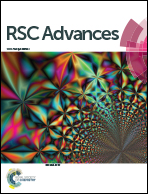Polycrystalline iron oxide nanoparticles prepared by C-dot-mediated aggregation and reduction for supercapacitor application†
Abstract
Pseudocapacitive transition-metal oxides are widely used as excellent electrode materials in high-performance supercapacitors due to their high capacitance, low cost and environmentally friendliness. Here, α-Fe2O3/Fe3O4 heterostructure nanoparticles as a three-dimensional, multicomponent, multiphase oxide were successfully prepared by a simple solvothermal method and C-dot-mediated aggregation and reduction. The working electrode based on heterostructure nanoparticles could be simultaneously used as an anodic and cathodic electrode, resulting in a specific capacitance of 150 F g−1 and 40.1 F g−1 at a current density of 1 A g−1 and 0.5 A g−1, respectively. The synergistic effect of heterostructure iron oxide allowed electron transport and ion diffusion between electrode and electrolyte and then electrochemical performance was improved. Moreover, when α-Fe2O3/Fe3O4 heterostructure nanoparticles were used as a cathodic electrode, the behavior of electrochemical double layer capacitors was observed. The results proved that heterostructure nanoparticle-based electrodes are promising candidates for supercapacitors.


 Please wait while we load your content...
Please wait while we load your content...